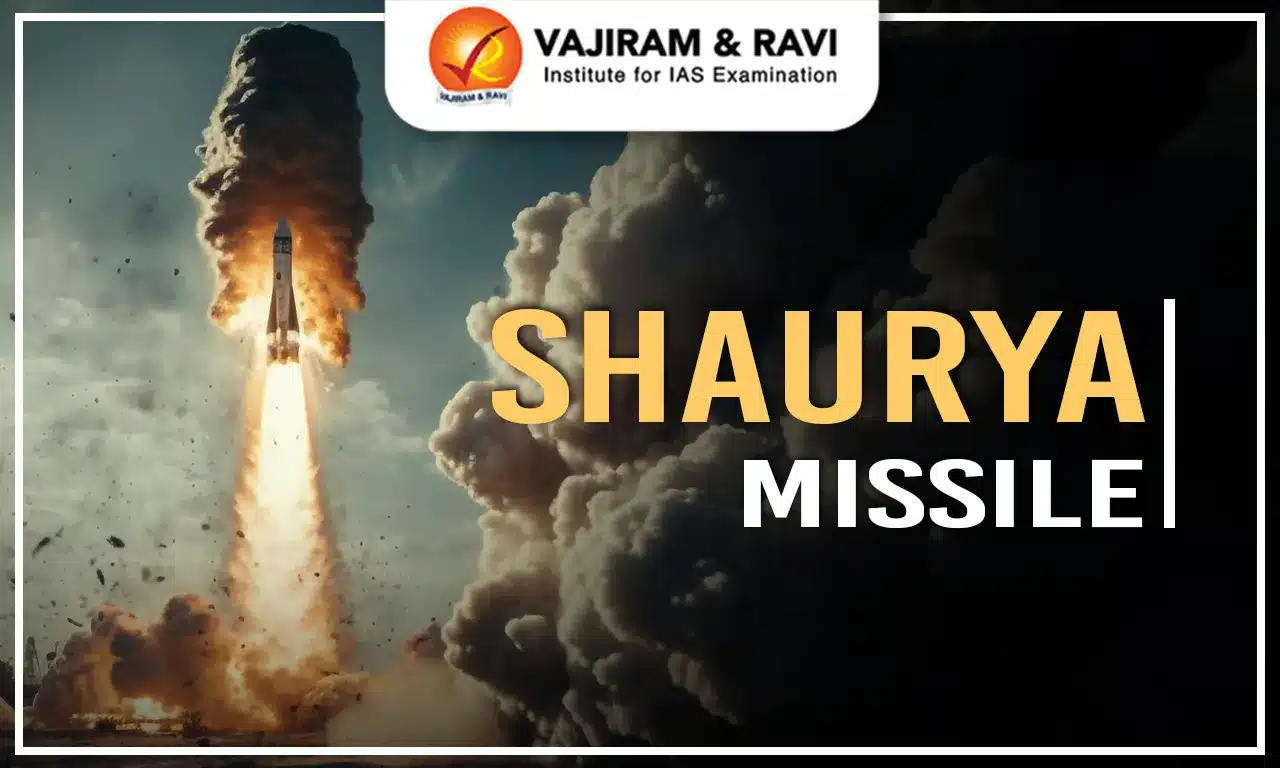The Shaurya Missile, meaning Valour is an indigenously developed, canister-launched, surface-to-surface ballistic missile designed by India’s Defence Research and Development Organisation (DRDO). First test-fired in November 2008, the Shaurya Missile has undergone a series of successful trials leading to its final design configuration. While it was initially believed to be a land-based adaptation of the submarine-launched Sagarika (K-15) missile, DRDO has since clarified that Shaurya is an independent project with distinct features.
Shaurya Missile
Powered by a two-stage solid-fuel rocket, Shaurya Missile is designed for high mobility, allowing it to evade missile defense systems while offering a rapid, stealthy launch capability from underground canisters. By 2011, the missile successfully demonstrated its full operational range of approximately 700 km, and an upgraded variant, capable of reaching 800 km, was user-tested in 2020. Later that year, the Indian government approved Shaurya Missile induction into the Strategic Forces Command, marking its formal entry into India’s strategic weapon.
Also Read: Missiles of India
Shaurya Missile Specification
Developed by India’s Defence Research and Development Organisation (DRDO), the Shaurya Missile represents a significant advancement in the country’s strategic strike capabilities. Designed as a surface-to-surface ballistic missile with hypersonic speed and precision targeting, Shaurya combines rapid deployability with stealth and survivability. The table below includes its core technical and operational Shaurya Missile Specification:
| Shaurya Missile | |
|
Specification |
Details |
|
Class |
Short/medium-range ballistic missile (surface-to-surface), with hypersonic terminal phase |
|
Range |
~700–800 km under standard configuration; unconfirmed depressed-trajectory tests suggest up to ~3,000–3,500 km |
|
Top Speed |
Up to Mach 7.5 (≈9,190 km/h); Mach 7 at 50 km altitude and ~Mach 4 at impact |
|
Propulsion |
Two-stage solid-fuel rocket; launched from a sealed gas-filled canister for rapid deployment and safe storage |
|
Launch Capability |
Land-based via truck-mounted transporter erector launcher (TEL); potential launch from submerged platform (barge/submarine) |
|
Dimensions |
Length: ~10–12 meters Diameter: ~0.75–0.8 meters |
|
Launch Weight |
Approximately 6–8 tonnes |
|
Payload Capacity |
Estimated 200–1,000 kg; supports high-explosive or nuclear warheads |
|
Warhead Type |
Primarily nuclear-capable, enhancing India's strategic deterrence capability |
|
Guidance & Accuracy |
Advanced inertial navigation system (INS) with ring-laser gyroscopes and accelerometers; CEP: 20–30 meters |
|
Terminal Features |
Hypersonic maneuverable descent phase, making interception extremely difficult |
|
Launch System |
Canisterized launch enables quick-response, all-weather operations from underground silos or mobile platforms |
Shaurya Missile Importance
- Shaurya Missile strengthens India’s nuclear posture by ensuring a credible and survivable second-strike option, in line with the country’s “No First Use” policy.
- The missile can be launched from mobile land-based platforms and potentially from submarines, offering flexibility and operational survivability.
- Developed by DRDO to reinforce India’s strategic deterrence, Shaurya Missile serves as a reliable response mechanism in case of a nuclear attack.
- With a range of ~750 km, Shaurya can effectively target all of Pakistan and, when integrated with longer-range systems like Agni, contribute to coverage of strategic locations in China.
- Shaurya Missile supports India’s nuclear triad by adding a mobile land and potential sea-based delivery system to the existing air and land-based arsenal.
- Its high speed (up to Mach 7.5) and maneuverability make it difficult to intercept, increasing the credibility of India’s retaliatory deterrent.
Also Read: Dhanush Missile
Shaurya Missile Development
The development of the Shaurya Missile followed a structured and carefully phased approach to ensure its performance, accuracy, and strategic viability. Beginning with its inaugural launch in 2008, After years of refinement and successful demonstrations including an advanced version with extended range, the Shaurya Missile was formally approved for induction into India’s Strategic Forces Command. The table below outlines the key milestones in Shaurya Missile Development journey:
| Shaurya Missile Development | |
|
Event / Phase |
Details |
|
Initial Launch |
First tested in November 2008 from an underground canister-based launch facility |
|
Design Validation |
Achieved full design range (~700 km) and Mach 7.5 speed during the third test on 24 Sept 2011 |
|
Advanced Variant Testing |
October 2020: DRDO conducted user trials of an upgraded Shaurya with ~800 km range |
|
Key Capabilities Demonstrated |
Terminal guidance, high-speed maneuverability, and enhanced accuracy |
|
Induction Approval |
Post-2020 trials, missile was cleared for induction into the Strategic Forces Command |
|
Deployment Status (as of 2023) |
Reported to be in initial deployment phase, strengthening India’s strategic missile arsenal |
Shaurya Missile vs Others
India's missile arsenal includes diverse systems like Agni, Prithvi, BrahMos, and Shaurya Missile, each serving distinct strategic roles. The table below compares these missiles based on range, speed, payload, launch platforms, and guidance capabilities.
| Shaurya Missile vs Others | ||||
|
Feature |
Shaurya Missile |
Agni Series |
Prithvi Series |
BrahMos Cruise Missile |
|
Type |
Short/medium-range ballistic missile |
Intermediate/Intercontinental-range ballistic missiles |
Short-range ballistic missiles |
Supersonic cruise missile |
|
Range |
~750–800 km |
~700 km (Agni-I) to 5,000+ km (Agni-V) |
~200–350 km (Prithvi-II/III) |
~290–400 km |
|
Speed |
Hypersonic (up to Mach 7.5) |
Subsonic to hypersonic (varies with variant) |
Subsonic |
Supersonic (up to Mach 2.8+) |
|
Warhead Capacity |
200–1,000 kg (nuclear/conventional) |
Up to ~1,000 kg |
~500–1,000 kg |
~200–300 kg (typically conventional) |
|
Launch Platform |
Canister-based (mobile land-based, potential underwater/silo) |
Mobile surface launchers (road/rail mobile) |
Mobile launchers (liquid-fueled, less mobile) |
Land vehicles, ships, aircraft |
|
Fuel Type |
Solid-fueled (2-stage rocket) |
Solid-fueled (Agni-I to V) |
Liquid-fueled |
Solid + liquid ramjet |
|
Guidance & Accuracy |
Advanced INS with CEP ~20–30 meters |
Modern variants with improved INS; CEP varies by model |
Older INS systems; lower accuracy (CEP ~100–200 m in early models) |
Precision strike capability; low CEP (~1–10 m) |
|
Strategic Role |
Second-strike, nuclear deterrence |
Long-range deterrence; targets deep inside adversary territory |
Tactical use, short-range battlefield support |
Tactical high-value target elimination |
|
Mobility & Deployment |
Highly mobile, rapid deployment via canisters |
Mobile but road-based launchers; slower to relocate |
Requires fueling and preparation; limited mobility |
Very mobile; ship-, air-, and ground-launched |
Last updated on November, 2025
→ Check out the latest UPSC Syllabus 2026 here.
→ Join Vajiram & Ravi’s Interview Guidance Programme for expert help to crack your final UPSC stage.
→ UPSC Mains Result 2025 is now out.
→ UPSC Notification 2026 is scheduled to be released on January 14, 2026.
→ UPSC Calendar 2026 is released on 15th May, 2025.
→ The UPSC Vacancy 2025 were released 1129, out of which 979 were for UPSC CSE and remaining 150 are for UPSC IFoS.
→ UPSC Prelims 2026 will be conducted on 24th May, 2026 & UPSC Mains 2026 will be conducted on 21st August 2026.
→ The UPSC Selection Process is of 3 stages-Prelims, Mains and Interview.
→ UPSC Result 2024 is released with latest UPSC Marksheet 2024. Check Now!
→ UPSC Prelims Result 2025 is out now for the CSE held on 25 May 2025.
→ UPSC Toppers List 2024 is released now. Shakti Dubey is UPSC AIR 1 2024 Topper.
→ UPSC Prelims Question Paper 2025 and Unofficial Prelims Answer Key 2025 are available now.
→ UPSC Mains Question Paper 2025 is out for Essay, GS 1, 2, 3 & GS 4.
→ UPSC Mains Indian Language Question Paper 2025 is now out.
→ UPSC Mains Optional Question Paper 2025 is now out.
→ Also check Best IAS Coaching in Delhi
Shaurya Missile FAQs
Q1. Is Shaurya a hypersonic missile?+
Q2. Which is the fastest missile in the world?+
Q3. Does India have any hypersonic missile?+
Q4. What is the speed of the Shaurya missile?+
Q5. Which is the fastest missile in India?+

















